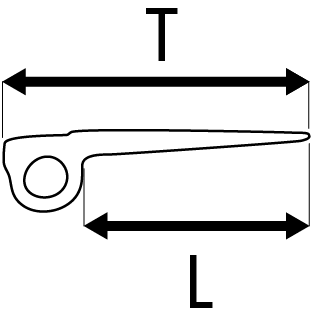How to choose the right piton?
What are Pitons?
A piton (also called a pin or hammer) in climbing is a metal point (usually steel) that is driven into a crack or seam in the climbing surface with a climbing hammer and that acts as an anchor to protect the climber from the consequences of falling or to make progress in climbing. Pitons are equipped with an eyelet or a ring to which a carabiner is attached; the carabiner can then be connected directly or indirectly to a climbing rope.
Classification of Pitons
"S" for standing and anchor belays and "F or P" for intermediate belays.
(S = belay pitons and F or P = runner pitons.)
| P | Progression pitons |
S | Safety pitons |
Pitons were the original form of protection and are still used where there is no alternative. Repeated hammering and pulling out of pitons damages the rock, and climbers who adhere to the clean climbing ethic avoid using them as much as possible. With the popularity of clean climbing in the 1970s, pitons were largely replaced by faster and easier to use clean protection, such as nuts and cams. Pitons are still found in place (as "fixed" pitons) on some established free climbing routes, as fixed belay station anchors, in places where nuts or cams will not work; and are used on some hard climbs.
Most common pitons:
Pitons are custom-made and manufactured to fit a wide variety of cracks. From small to large, the most common are:
- Blade Blade - also known as Bugaboos, are thin, straight hooks that work in thin, deep cracks.
- Lost Arrow - designed by John Salathé and Yvon Chouinard, is a hot-forged, tapered piton that performs well in medium-sized cracks.
- Corner - A piton made of sheet steel bent into a "U", "V" or "Z" shape; works well for larger cracks, where the steel deforms elastically as the piton is set.
- Bongs - The largest pitons are corners made of sheet aluminum, called bongs, named for the sound they make when hammered into place, or the sound they make when dropped. Bongs have become rare with the advent of cam units, chocks that protect the same wide cracks more easily, and without causing damage to the rock.
- Beaks - hooking hooks with the ability to hook, that can be set without a hammer. Often known as Birdbeaks named after Jim Bridwell whose nickname was "The Bird".
- RURP (Realized Ultimate Reality Piton) - a small piton about the size of a postage stamp used in thin, shallow seams. It was designed by Tom Frost and Yvon Chouinard in 1959 and was manufactured by Chouinard Equipment in the 1960s. It is not a strong piece and is mainly used for aid climbing, although it can be used as protection on extremely free routes (e.g. Rurp The Wild Berserk (E6 6b) at The Brand, Leicestershire, UK). More recent versions of the RURP include Bird Beaks and Peckers.
Also based on source: https://en.wikipedia.org/wiki/Piton
Canyonzone's range see: Anchoring & Accessories \ Pitons
Overview Knowledge base General canyoning and caving equipment : Go back.
CanyonZone
-
- Experts in canyoning & caving gear - ship worldwide
-
- Rent outdoor equipment
- New items in assortment
- Special offers
- Pre-ordering 2025
- NEW - Petzl Canyoning / Caving Line 2025
- 2nd hand canyoning caving articles
- Items / packages customer specific
- Giftcards of CanyonZone
-
- Canyoning (basic) equipment
- Canyoning equipment packages
- Luggage / Travel Bags
-
Canyoning Neoprene clothing
- Size charts by Brand
- Aventure Verticale (AV) size charts
- CE4Y neoprene size charts
- GUARA neoprene size charts
- Seland neoprene clothing size charts
- Newex neoprene size charts
- NRS neoprene size charts
- Vade Retro neoprene size charts
- Custom made neoprene wetsuit, required size data
- Canyoning Wetsuits
- Protective Canyoning Clothing
- Canyoning Neoprene Headgear
- Canyoning Drysuit / Undersuit
- Canyoning Neoprene shirts & shorts
- Canyoning Knee - elbow protectors / pads
- Canyoning Neoprene gloves
- Canyoning Neoprene socks
- Canyoning shoes
- Harnesses & Accessories
- Helmets outdoor sports
- Carabiners & maillons
- Descend devices
- Ascending / Rise along rope
- Pulleys
- Rope & webbing slings
- Anchoring & accessories
- Via Ferrata / Klettersteig sets
- Outdoor Gloves / (ice-)canyoning, caving, via ferrata
- Canyoning Back Packs, bags & duffels
- Drybags & Kegs, Boats
- Outdoor Knives & Scissors
- Safety in outdoor sports
- First Aid / Medical Articles
- Rescue in outdoor sports
- Camping, Bivouac & Backpacking
- Winter- / Ice Canyoning
-
Canyoning Books & Topographic Maps
- Map Pouch
-
Canyoning Guide Books
- Australia
- Austria
- France (including Corsica and La Reunion)
- Germany
- Greece (including Crete) / Balkans
- Israel
- Italy (including Sardinia)
- Jordan / Middle East
- Morocco
- New Zealand & Australia
- Portugal (including Madeira and Azores)
- Scandinavia
- Slovenia
- Spain (including Canary Islands and Majorca)
- United Kingdom (UK) / Scotland
- United States of America
- South America
- Switzerland
- Turkey
- Canyoning Techniques & Skills
- Canyoning Maps
- Outdoor Children's Books
- Outdoor DVDs
- Via Ferrata / Klettersteig books
- Repair & Maintenance
- Miscellaneous items outdoor sports
-
- Especially for Ladies
- Especially for Children
- Especially for Instructors and Guides
- Especially for Outdoor Sports Companies
- Especially for Underwater / Cave diving / Diving
-
- Caving (basic) equipment
- Caving equipments packages
- Caving Suits / Overalls
- Caving Under Suits
- Caving Boots / Wellies
- Caving Socks
- Caving Knee- and Elbow Pads
- Caving Gloves
- Headlamps & torches
- Caving Bags & BackPacks
- Tents and Bivi bags
- Caving & Potholing Books
-
-
Climbing related gear: on request
-
- Services
-
- CanyonZone New(s)
- CanyonZone Customer Service
- Contact about Assortment
- Business ordering at CanyonZone
- About CanyonZone
- CanyonZone's FAQ
- CanyonZone's Knowledge Base
- About CanyonZone, owner Gertjan van Pelt
- Works together with
- Link exchange
-
- Privacy
- Terms and Conditions
-
Terms and Conditions Rental
-



